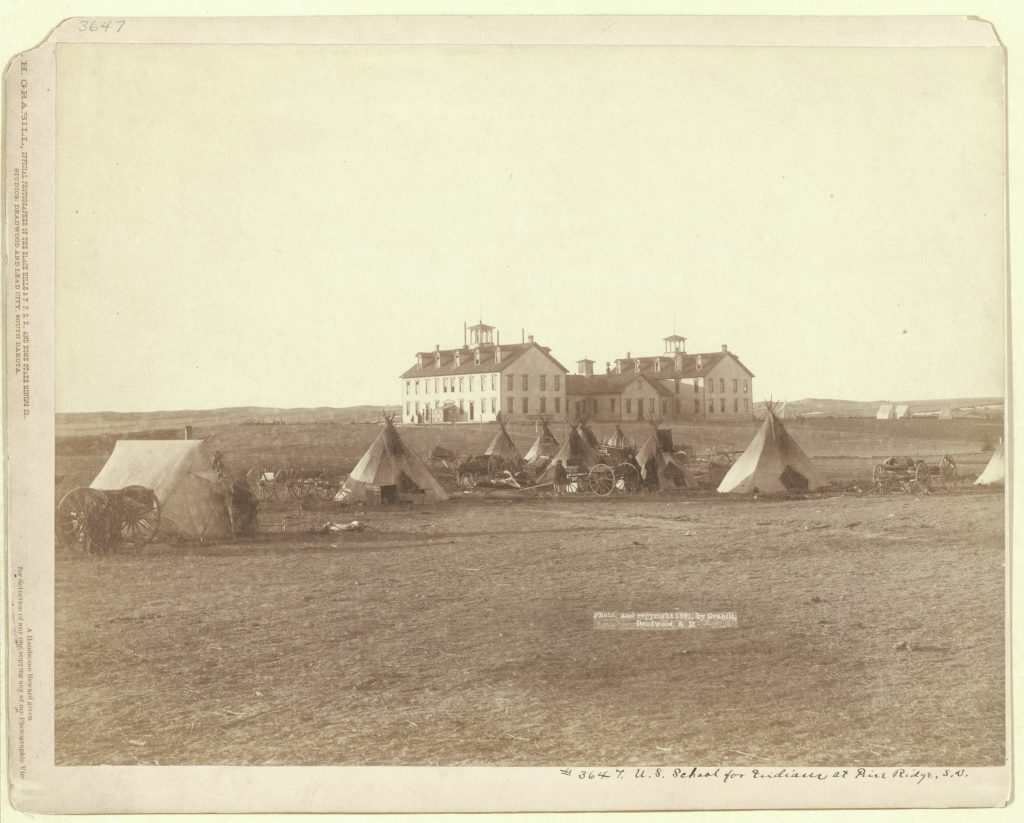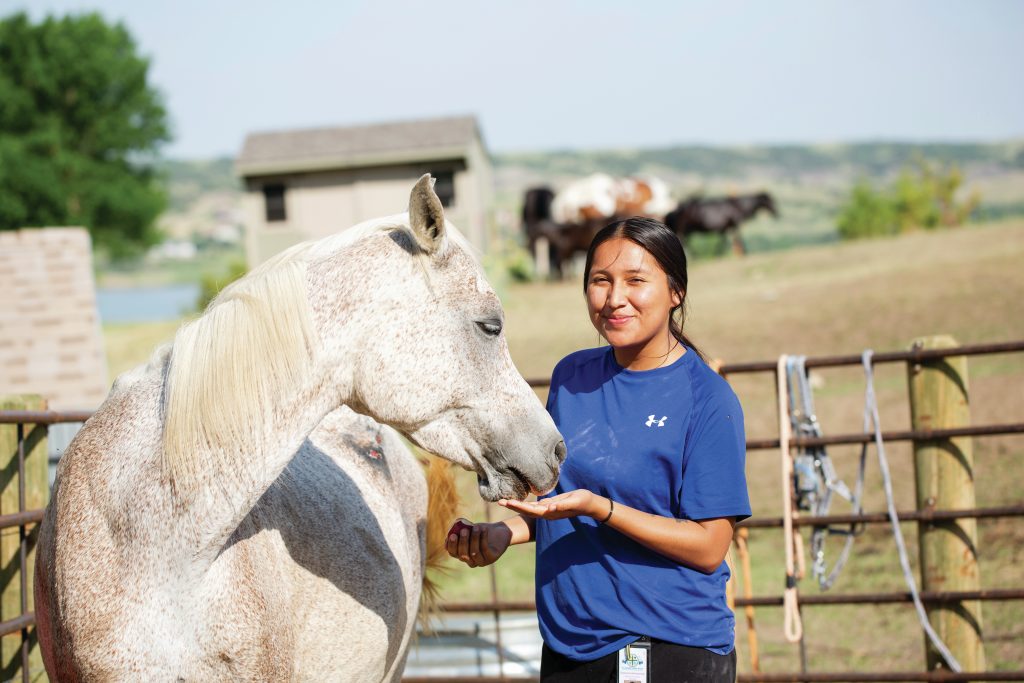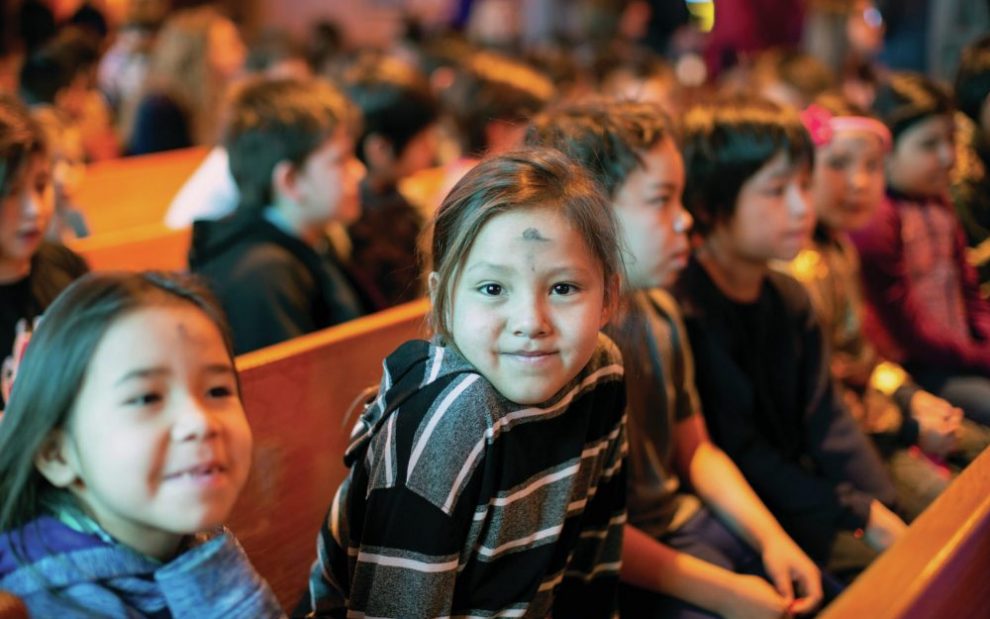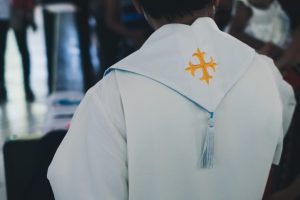It’s the Moon of Snowblindness on the Pine Ridge Indian Reservation. It’s been a cold March with the temperature often below zero. The road passes Wounded Knee and its cemetery on the hill to the west then rises up over the land, the snow-covered plains falling away to the east. As my car rises into the sky, a herd of horses appears alongside and runs with the car, making me think of Black Elk’s vision of dancing horse nations.
When I arrive at my destination, drums signal the beginning of Yutapi Wakan, the ceremony of sacred food. Waves of purifying smoke wash over us. Images of Wanikiya, “He Who Makes Live,” and the ancestors look down at us from the walls. A star quilt hangs behind the fires burning on the altar. Today is the start of the season of purification, and ashes from the sacred fire mark our bodies.
It’s Ash Wednesday at Our Lady of Lourdes Catholic School.
Once an outsider settles in, they see that, despite the rich Lakota texture, the ceremony is much like any Catholic school Mass across North America. Squirming children whose bodies are calling them to run around outside are packed tight in the pews. The general bustle is punctuated by seemingly impossible bouts of stillness. It’s the same liturgical structure, the same Eucharist. You can’t get more Catholic than this: Outside the church, there’s even the site of a reported apparition of the Blessed Mother.
After 25 years of studying Native American Catholicism, its unique vibrancy still surprises me: the universality of the Catholic faith and the beauty of its particular local expressions, the drama and horror of its history, and the deep spirituality and countless examples of heroic witness among its people. Native American Catholic schools have all of that and are charting a new path forward, not only among Native Catholics but in the church as a whole.
Twenty percent of Native Americans are Catholic, many unapologetically, and have been for generations. Today, 26 Catholic schools serve the educational needs of Native American Catholic children and their non-Catholic neighbors throughout the United States.
At their core, Native American Catholic schools are no different from any other Catholic schools in North America. They seek to provide a quality education and Catholic religious formation that is at home in their communities and specific to their cultural context.
At the same time, Native American Catholic schools have a history unlike any others in the United States, a story that is rarely told in all its complexity. Catholicism and Catholic schools were, in part, brought by missionaries and imposed by the government. Yet there is a second, more important strand to the story: Catholicism was also birthed from within. Many Natives actively sought out the Catholic faith and engaged it on their own terms. In the case of Pine Ridge, it goes back to St. Kateri Tekakwitha.
In the beginning
In 1816, 24 Catholic Mohawk fur trappers working for the North West Company settled with the Salish in what is now the northwest United States. The Mohawks were Catholics from Kahnawake, the Mohawk Catholic village where St. Kateri settled.
The Mohawks (Rotinnonhsion:ni—People of the Longhouse) told the Salish of the Catholic way. Rose-Alma McDonald, a Mohawk Catholic lay minister from Akwesasne and international consultant with Katenies Research and Management Services, isn’t surprised they spread their faith. “Mohawks always bring their faith with them,” she says. “It makes sense to me that they would share the faith and that St. Kateri was working through them. In my work, I’ve seen that St. Kateri has had a powerful influence across all North American tribes. I believe she was the conduit.”
Intrigued by the Mohawks’ message, the Salish sent a delegation on a 1,500-mile journey to St. Louis to ask for “Black Robes,” or Jesuits, to settle among them. Initially unsuccessful, they tried again. And again.
The Salish finally got a response on the fourth try, and Father Pierre-Jean De Smet journeyed to them in 1840. Over the next decades, De Smet crisscrossed the West multiple times. He, along with other Black Robes, made a favorable impression on the Lakota for their spiritual way of life and their willingness to enter Lakota spaces on Lakota terms, such as De Smet’s 1868 parlay with Sitting Bull during the Great Sioux War.
Lakota and Jesuit encounters began a spiritual exchange that continued the cross-cultural relationship begun when the first traders arrived. The Lakota had goods and ideas that the newcomers desired. The reverse was also true.
Maka Black Elk is the director for truth and healing at Red Cloud Indian School, the Catholic school on Pine Ridge. “Lakota people were practical people. When things worked better, like metal pots for cooking, they readily adopted them,” he says. “They formed alliances through intermarriage. The children that they produced were called iyeska, or ‘interpreters,’ and were very desirable for their biculturality.”
I may not have been completely asked for, but a Lakota Catholicism formed based on a genuine flash of mutuality.
The Black Robes’ integrity stuck with the Lakota and became a resource in navigating their colonial reality. When the U.S. government imprisoned the Lakota on reservations, they assigned Episcopalians to Pine Ridge. Red Cloud successfully lobbied for Jesuits instead, seeing them as trustworthy partners in forging a new way forward through uncharted waters.
The Lakota–Jesuit partnership led to vibrant faith communities where the Lakota language was the norm. About 50 percent of the people became Catholic. The Jesuits delegated significant authority to local lay leaders, such as Servant of God Nicholas Black Elk, who interpreted the Catholic faith through a lifetime of formation in Lakota lifeways. In the hands of these Lakota elders, the anticolonial theology of the Ghost Dance lived on and provided a liberative edge. At their best, the early Jesuits, who as German refugees learned to speak Lakota, were a form of iyeska between the Lakota and settler society. It may not have been completely asked for, but a Lakota Catholicism formed based on this genuine flash of mutuality.
Missed opportunities
At first, Catholic education came out of this context of Lakota agency. Many, like Nicholas Black Elk, wanted Catholic spiritual formation for their children. Many also wanted their children to learn English and skills in the trades. The Lakota knew that their survival in the new colonial reality depended on being able to play by the rules of the dominant society. “I think there is an argument to be made that many people initially engaged education for the same reasons that iyeskas were desirable, that through it you could engage the wider world on your own terms,” Maka Black Elk says.
The Lakota didn’t see their interest in education as taking place at the expense of the Lakota language and lifeways. Catholic schools didn’t have to take this approach either, given the general purpose of American Catholic education at the time. Many Catholic schools were ethnic schools that played an intentional, almost militant role as guardians of a people’s spiritual and cultural traditions.

Credit: Library of Congress, Prints and Photographs Division, John C. H. Grabill Collection
From this perspective, the founding of Holy Rosary Mission and School on Pine Ridge and the arrival of the Sisters of St. Francis of Penance and Christian Charity could have been a moment of real possibility. It’s tempting to imagine what could have been: a dual-pronged education rooted in both Native American tradition and preparation to engage the modern economy infused with a holistic Catholic spirituality.
Tragically, this initial flash of mutuality and moment of possibility collided with a much more powerful force. Catholic schools, like all schools on reservations regardless of church affiliation, were a department of a larger prison system designed to rid the young nation of people who refused to get out of the way of “civilization.” The most brutal and un-Christlike segment of the American population unapologetically advocated complete extermination of Native peoples. Those with enough Christian formation recognized the humanity of Native peoples and offered a less violent option: reprogram them and assimilate them into mainstream society.
Children were wrestled away from their families through means that ranged from coercion to literal abduction. Separation from their cultural context required separation from families and communities: This meant months and years without the tactile, embodied love of parents and elders. They were often housed in prison-like warehouses where physical punishment and social humiliation structured the culture. Some suffered sexual abuse. Gen. Richard H. Pratt’s famous dictum captured the militarized brutality: “Kill the Indian, save the man.”
For average Americans, it’s easy to think that this is distant history or only exists in remote corners of the United States. Others, by reflex, point to good people within the system or Native Catholics who report good experiences. But you don’t have to look far to see that the devastating legacy of the residential school system lives on. Father Maurice Henry Sands, a priest from the Archdiocese of Detroit, is an enrolled member of the Little Traverse Bay Bands of Odawa Indians in Michigan and a member of Bkejwanong First Nation in Ontario. He lives and works in Washington, D.C. as the executive director of the Bureau of Catholic Indian Missions. Sands’ family tree is filled with residential school survivors, and he knows the cost firsthand.
“My grandfather, Isaac Sequajaw Willis, was initially forcibly taken away from his parents at the age of 4 to attend a boarding school in Michigan, a couple hundred miles from his home,” Sands says. “At 5 he was sent even farther from home to a boarding school in Nebraska for three years. After that, they moved him to the Tomah Indian School in Wisconsin until he finished high school. And after finishing high school, he went to the Carlisle Industrial Indian School in Pennsylvania.”
Sands’ grandfather was separated from his family for almost two decades, forced to live in four schools in four states. And the most surprising detail is that his family had already made the transition that the residential school system wanted to enact. “My grandfather came from a very good, stable Catholic family,” Sands says. “They were already farmers who had been productive and responsible members of their communities for many generations. And my grandfather was cruelly and involuntarily taken away from that life.”
Government officials literally lured them into automobiles with offers of ice cream or new clothes and, without notifying their parents, transported them to faraway boarding schools.Father Maurice Henry Sands
This cannot be overlooked: In the eyes of the government, it did not matter if you were already a member of a Christian denomination or competent in the new socioeconomic system they wanted to impose on Indian Country. The residential school system was strictly about eradicating the Native peoples’ cultures, languages, identities, and ways of life, and in service of that no one was exempt. This is not ancient history, Sands says. “This boarding school system had a very devastating effect on the family of my mother. And the experiences of both of my maternal grandparents in the residential boarding schools continue to have a devastating impact on all of the members of my family to the present day. A number of my cousins were taken away in the ’60s. They called it the ‘Sixties Scoop.’ Government officials literally lured them into automobiles with offers of ice cream or new clothes and, without notifying their parents, transported them to faraway boarding schools or to live with non-Indian foster parents.” When I ask whether these were Catholic or non-Catholic schools, Sands replies: “Both.”
An honest look at this history uncovers deep contradictions that should make any Catholic shudder. A pro-family organization that teaches that the family is the first church took children from families. A political body that teaches subsidiarity worked against local tribal authority in service of an occupier’s Orwellian scheme. A school system created in part to protect Catholics from the overreach of a secular and often explicitly anti-Catholic government worked to finish that government’s conquest. It’s something like taking Jesus away from the holy family to be educated by centurions.
The legacy of residential schools
Some Native students emerged relatively unscathed. Many others were deeply wounded. Words on a page can’t capture the trauma that many live with. In Walking the Good Red Road: Nicholas Black Elk’s Journey to Sainthood, a documentary about Black Elk’s life, Patricia Catches and Basil Brave Heart give a clear window into this pain, describing how a young child who didn’t know a word of English was forbidden to speak her language and how a boy had his hair forcibly cut and discarded like trash. They describe the history of these schools through the lens of its effect on living human beings. “[My schooling] was an attack on who I was,” Brave Heart says.
Catches agrees, saying, “This was a totally different world . . . that the white society implemented on Indian people. And I’m a living example of it.”
The greatest tragedy is that many students didn’t make it home. Children died, mostly of disease, and were buried at the schools. Families sometimes didn’t even know the details. Although well-known in Native communities, it is only in the last few months that events made this common knowledge. In Kamloops, British Columbia, the site of the largest residential school in Canada, ground penetrating radar revealed 215 bodies in unmarked graves. Shortly after, at Cowessess First Nation in Saskatchewan, another cemetery of 750 children was found, the headstones intentionally removed.
The effect in Native communities has been intense. “It was like somebody picked a scab off a massive wound,” McDonald says. “For a long time, people told us our truths were made up. ‘Get over it,’ they said. But here is graphic proof that can’t be denied. At the same time, these revelations are a huge trigger for survivors and their relatives. It brings the trauma back up to the surface, and now the whole world knows. Now we all have to heal, but the question is how?”
In Native communities, feelings are often extreme and from all sides of the spectrum. “On one side, there’s a lot of anger at the church and skepticism about motives. Some believe that the only thing that will bring healing is every priest leaving,” Maka Black Elk says. “On the other side, there are people who support the school and the church but who differ on the truth and healing process. [I’ve heard people say] they are a proud Catholic and glad that the process was going forward. Other Catholics think that this is a mistake, that it will only bring back trauma. What is unifying is the acknowledgment that there is a wrong to overcome in a harmful history.”
In this situation, some would say it would be easier if the church left reservations altogether. That’s not the solution for Maka Black Elk. “Leaving may take away a trigger, but it doesn’t solve the problem,” he says. “Healing means that you no longer feel threatened. People are hurt and angry—and I must emphasize that this is understandable—but we want to create a future where Indigenous peoples are strong in who we are and confident in the face of difference.”
Maka Black Elk continues, saying, “That’s why the church has a responsibility not to leave, not so much for itself but for Indigenous peoples. Dealing with the fallout of colonialism is always left to the colonized. It’s the church’s responsibility to step up and reckon with the healing that [needs to happen].”
Dealing with the fallout of colonialism is always left to the colonized. It’s the church’s responsibility to step up and reckon with the healing that [needs to happen].Maka Black Elk
Maka Black Elk is at the forefront of untangling the knot on Pine Ridge. The first step must be what happens in the sacrament of confession: Tell the truth about what happened. In this case, open the records and listen to all the stories. There must be genuine contrition. The proper reparations must be discerned. Then true healing can happen.
Organizations have always tended to cover up scandal, and the openness of the truth and healing process may make some defensive. But Maka Black Elk is quick to emphasize that the reconciliation process is not against Catholic education but in service of it, something that is very important to him. “I deeply value Catholic education,” he says. “I went to Red Cloud, the University of San Francisco, and the University of Notre Dame. The Catholic spirituality and values that I received through Catholic education are important parts of who I am.”
When I ask Maka Black Elk if he wants to share a memory to illustrate his point, he turns wistful. “In high school, a Jesuit offered a silent retreat in the Jesuit community. Three of us students signed up. It was very Catholic—Mass, Liturgy of the Hours, silent prayer—but incorporated the sweat lodge. It just so happened that the three of us represented the whole spectrum of Pine Ridge: One was traditional Lakota, one was Catholic, and then me, who grew up doing both,” he says. “The retreat was a powerful prayer experience and just a great time on a human level. Before this, I only saw the Jesuits in the classroom and viewed them as separate, living in a kind of ivory tower. Praying with them in their community humanized the Jesuits for me.”
The retreat was also a glimpse of what the truth and healing process could lead to. “I wouldn’t have been able to say this at the time, but looking back that experience represents what is possible for Red Cloud and Native American Catholic schools: a space where the full spectrum of our community can engage the best of Native and Catholic traditions,” Maka Black Elk says.
A better future
On the bank of the Mnišoše, the Missouri River, another ceremony is under way. Yesterday, the whole community was at Yutapi Wakan. Now, we are outside, and the smoke and prayers drift in the autumn breeze rippling through the cottonwoods. It’s Indigenous Peoples’ Day at St. Joseph’s Indian School, a Catholic school in Chamberlain, South Dakota. The school teaches grades one to eight and offers housing, counseling, life skills, and other services to high school students who attend the public school in town.
St. Joseph’s is one of seven schools that make up the American Indian Catholic Schools Network (AICSN), an umbrella organization working to address the big picture questions. “The mission of these schools is to provide a transformative Catholic education that celebrates Indigenous culture, language, and spirituality,” says Will Newkirk, director of AICSN.

Courtesy of St. Joseph’s Indian School.
Newkirk says these schools celebrate and honor Indigenous culture while remaining rooted in Catholic identity like any other Catholic school. “Native American Catholic schools are just like any other Catholic schools, based on the gospel and Catholic social teaching,” he says. “We are in complete agreement with Archbishop James Hickey [the former leader of the Archdiocese of Washington, D.C.] who said, ‘We don’t teach them because they are Catholic, we teach them because we are Catholic.’ ”
AICSN is also trying to bring more fully to life the vision of Maka Black Elk. “Before Kamloops we were in agreement that truth and healing is a priority,” says Newkirk. “Now it needs to be at the heart of what we do.”
Still, it’s a challenge to live with the reality that history will always be one element of your public image. A residential school founded in 1927 by the Priests of the Sacred Heart as an alternative to the federal boarding school system, St. Joseph’s has its share of blemishes. The school is doing its best to recognize that part of its history and do things in the right way now and in the future. Clare Willrodt, director of communications and outreach at the school, says, “We’ve made missteps in this process before and probably will again. But we continue to try and grow into all the implications of truth and healing and keep in perspective that the most important parts of this community are the children and families with whom we partner.”
The living present is bigger than any part of a flawed history. St. Joseph’s strives to provide a stable, loving place for Native American children, some of whom have experienced deep trauma and a few who have nowhere else to go. St. Joseph’s curriculum contains American school content and Catholic spirituality, but more and more is based on Lakota lifeways: language, history and culture, archery and traditional crafts, and Lakota spirituality. Currently, the school is putting the finishing touches on developing a tool for measuring student growth based on an Indigenous worldview.
There’s no clearer witness to the school’s approach than the horses. Pony Boy, Sox, and Cochee came to St. Joseph’s in 2019 and are the pillars of the equine therapy program. Gramma, a fourth horse, just gave birth to a filly named Willow. The horses offer themselves to the children to be brushed, painted, and have their manes braided. They take the children on walks through campus and occasionally host the monthly Daughters of Tradition meeting, where young women eat; have sweat, smudge, and pray; and hear stories and teachings.
Patty Bourne, an Oglala from Pine Ridge who lives on Crow Creek Reservation, leads the program. “I can’t express how much the horses love these kids. They mirror you, reflect your emotions, and open you up. I don’t have words for it, how they give their healing energy to the students,” she says.
He’s angry, and he should be. But this land didn’t do it. The buildings didn’t do it. Those who did are gone, and it’s a different place now. It’s a place that’s working to heal those wounds.Patty Bourne
For Bourne, it’s about relationship. “The horses watch the children playing from afar, in the playground or with a basketball. They used to be wild and hard to catch before they came here. Now when the kids come in the pen, the horses come over and surround them,” she says. “They want to be loved and give their love, and the kids respond.”
Bourne understands the complicated history of Native Catholic schools. Her husband attended St. Joseph’s in the late 1960s and early ’70s and didn’t like it. He ran away and was punished. “He’s angry, and he should be,” she says. “But this land didn’t do it. The buildings didn’t do it. Those who did are gone, and it’s a different place now. It’s a place that’s working to heal those wounds.”
More than anywhere on campus, it’s the horses and Bourne who embody a better future. “I get so sad when the school year ends and the kids go home. There’s no laughter. I get so excited when the new year starts and they come back. It’s like Christmas,” she says.
When I ask her about her hopes for the future, there is no grandiosity, nothing epic, just the quiet, rooted presence of the horses. “I’m doing what I’m supposed to be doing,” she says, words that just as easily could have come from the horses. “As long as we don’t stop, keep building, and setting the bar a little higher, we’ll be doing what we are supposed to be doing.”
There is something profound about seeing the horses with the children by the banks of the Mnišoše that goes deeper than the artificial divisions imposed on Native communities. Nothing is more Native than horses, and yet they didn’t arrive until after contact. Although once new to Turtle Island (North America), they are not foreign but sacred relatives that reveal glimpses of the Creator who is beyond human capacity to fully understand. They were, after all, guardians of the Four Winds that Zechariah saw patrolling the Earth. Horses danced for Black Elk in his Great Vision. And they are now leaders in the work that Native American Catholic schools are striving for, establishing right relationships and allowing a better future to emerge.
This article also appears in the September 2021 issue of U.S. Catholic (Vol. 86, No. 9, pages 26-30). Click here to subscribe to the magazine.
Image: Courtesy of St. Joseph’s Indian School














Add comment